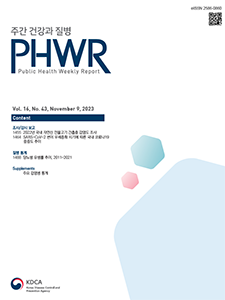Current Issue
Vol.16 No.43, November 09, 2023
-
Surveillance Reports 2023-11-09
 1
1
 2317
2317
 489
489
The Survey of Infection Status of Clonorchis sinensis Metacercariae of Freshwater Fish in 2022
Myoung-Ro Lee, Jung-Won Ju, Seon-Ok Baek, Young-Ju Lee, Hee-Il Lee
Public Health Weekly Report 2023; 16(43): 1455-1463 https://doi.org/10.56786/PHWR.2023.16.43.1 Abstract
AbstractThe Division of Vectors and Parasitic Diseases, Korea Disease Control and Prevention Agency have been investigated the infection status of Clonorchis sinensis metacercariae (CsMc) in freshwater fish as part of an effort for reducing the parasite infection rate in the Republic of Korea. In this survey, all fishes were collected in 10 regions and examined infection rate using the artificial digestion method. The infection rate of CsMc was highest in Youngjeon Stream (50%) located in Chungsong-gun, Gyeongsangbuk-do. The infection rate of CsMc by fish species was highest in Pungtungia herzi with 1,258 CsMc followed by Squalidus japonicus Koreanus, Microphysogobio yaluensis, Pseudorasbora parva, Acheilognathus lanceolatus. Infection risk that infection intensity per fish was highest in Gilan Stream with 62.3. To reduce infection rate of Clonorchis sinensis (C. sinensis , Cs), it is necessary to conduct survey on infection risk in C. sinensis prevalent areas and provide information to local residents people about at the level of infection risk.
-
Surveillance Reports 2023-11-09
 9
9
 1720
1720
 223
223
Severity of COVID-19 Associated with SARS-CoV-2 Variants Dominant Period in the Republic of Korea
Se-Jin Jeong, Misuk An, Minjeong Jang, So Young Choi, You-Jung Choi, Jinhwa Jang, Boyeong Ryu, Shin Young Park, Seong-Sun Kim
Public Health Weekly Report 2023; 16(43): 1464-1487 https://doi.org/10.56786/PHWR.2023.16.43.2 Abstract
AbstractThis report seeks to compare and analyze the severity trends of coronavirus disease 2019 (COVID-19) in Republic of Korea during periods of dominant variant virus prevalence. The analysis covers the period from January 20, 2020, to July 31, 2023, categorizing the severity of COVID-19 cases both throughout the entire period and during periods of dominant variant virus prevalence. Up until July 31, 2023, a total of 34,082,179 confirmed cases of COVID-19 have been recorded, resulting in 37,760 cases (0.11%) of severe illness and 35,644 deaths (0.11%). During the dominant prevalence of the Omicron BA.1 and BA.2 variants (from January 16, 2022 to July 9, 2022), severe cases and deaths were most widespread, accounting for 10,460 cases (27.7%) of severe illness and 18,679 deaths (52.4%). Concerning case severity rate and case fatality rate, the period before the dominant prevalence of the Delta variant (from January 20, 2020 to July 24, 2021) had the highest rates at 2.98% and 1.15%, respectively. In contrast, during the dominant prevalence of the Omicron XBB variant (from April 16, 2023 to July 31, 2023), these rates were at their lowest, reaching 0.12% for severity and 0.04% for fatality. Despite the continuous emergence of new variant viruses after the onset of COVID-19, the case severity rate during the dominant prevalence of the Omicron XBB variant has decreased to 0.04%, comparable to the risk level seen with influenza. However, the case fatality rate by age group is <0.01% for 0–49 years old, 0.01% for 50–59 years old, and 0.03% for 60–69 years old, while the case fatality rate for 80+ years old is 0.56%, which is still higher than other age groups, so the prevention policy of prioritizing high-risk groups should be continued.
-
QuickStats 2023-11-09
 2
2
 693
693
 301
301
Trends in Prevalence of Diabetes, 2011–2021
Public Health Weekly Report 2023; 16(43): 1488-1489 https://doi.org/10.56786/PHWR.2023.16.43.3

pp. 1~2097
Most Keyword
?
What is Most Keyword?
- It is the most frequently used keyword in articles in this journal for the past two years.
Most Read
-
Waterborne and Foodborne Disease Outbreaks in the Republic of Korea, 2023
Myung-Jae Hwang, So Yeon Park, Hyungjun Kim, Se Jeong Yang, Sungchan Yang, Jin Seon Yang
Public Health Weekly Report 2025;18: 17-32 https://doi.org/10.56786/PHWR.2025.18.1.2 -
Implementation Plan for the Coronavirus Disease 2019 Vaccination for the 2024–2025 Season: Recommendations of the 6th Expert Committee on Immunization Practices
Hyewook Hwang, Wookeon Lee, Seohyeon Ahn, Young-Sook Choi, Seunghyun Lewis Kwon, Dongwoo Lee, Eun Hwa Choi, SokGoo Lee
Public Health Weekly Report 2025;18: 90-102 https://doi.org/10.56786/PHWR.2025.18.2.3
Editorial Office
+82-43-719-7569





 Full Text
Full Text Cite
Cite


